March itinerary in Japan Day 3 (Hiroshima Meal edition)
(Thursday, March 24)
Table of contents
1. FUKUBEER
After enjoying a walk in the “Takehara Preservation District of Important Historical Buildings”, I drank FUKUBEER at “Roadside Station Takehara”. FUKUBEER is a golden ale containing honey from “FUKUBEE”, which runs an apiary in Tanoura, Takehara City. It is a collaboration product of “FUKUBEE” and Iwami Bakushu in Iwami City, Iwate Prefecture. Although it is a beer, it contains honey, so it was a beer with a gentle taste that was perfect for drinking in the morning.
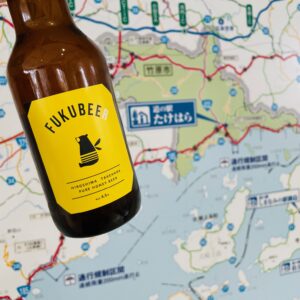
FUKUBEER doesn’t hit much even if I search the Web, so I think it’s a limited beer with a small amount of production. Especially for women who are not good at bitter taste of beer, I think it is a perfect beer, so I would like to expect it to be sold nationwide. The design of the beer bottle was also cute.
“Roadside Station Takehara” sells a lot of locally grown vegetables, and many Takehara citizens enjoyed shopping even in the morning. I liked the bright and clean building of “Roadside Station Takehara”. Before and after walking around the “Takehara Preservation District of Important Historical Buildings”, we recommend this “Roadside Station” to tourists.
2. Onomichi Ramen Kukai
After arriving at Onomichi Station, I ate Onomichi ramen at “Kukai“. Onomichi ramen is a local ramen that is famous nationwide for its soy sauce-based soup with fatty upper part of roast pork and flat noodles.

Looking at Wikipedia, it seems that there are two types of Onomichi ramen. “Onomichi ramen is said to have started in 1947 with Chinese noodles served at a stall by Zhu Atshun from Taiwan in Onomichi. The number of ramen shops that sell the same type of ramen as the souvenir Onomichi ramen that was sold by Amochinmi, a dainty maker in Tomonoura, Fukuyama City is increasing. And in general, when we talk about Onomichi ramen, we often refer to 2nd type.” Yoji Iwaoka, the founder of the Shin-Yokohama Ramen Museum, said that it might be better it “Onomichi / Fukuyama Ramen” because Amochinmi is a manufacturer in Fukuyama City.
In any case, it seems that the name of Onomichi has improved along with the rise of the name of Onomichi ramen nationwide, and I think there was a synergistic effect.
The Onomichi ramen of “Kukai” was delicious with a gentle taste. However, I wondered if the noodles were a little soft. The owner was very polite and kind.
3. Omichi Roman Coffee
While walking around Onomichi, I took a break at “Onomichi Roman Coffee” in the Onomichi Hondori shopping street. The interior of the coffee shop is classical and has a nostalgic atmosphere. The homepage of “Omichi Roman Coffee” also said, “Aiming to be a long-established coffee specialty store rooted in the local area.”
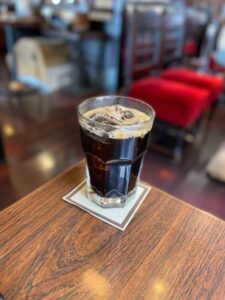
“Omichi Roman Coffee” is a home-roasted coffee shop where coffee brought by siphon is poured into a glass filled with ice in front of customers. It was a very strong and delicious coffee because it was for two cups of coffee. There weren’t many people in the Onomichi Hondori shopping street, but it turned out that “Onomichi Roman Coffee” was quite crowded and it was a popular coffee shop in Onomichi. It is a recommended coffee shop.
4.Izakaya “Umi no Kohachi”
After arriving at Fukuyama Station and checking in at the hotel, I had dinner at the izakaya “Umi no Kohachi”. “Umi no Kohachi” is located under the elevated railway tracks at Fukuyama Station.
I ordered “Assorted sashimi”, “pickled mantis shrimp”, “fried Nebuto (cardinal fish)”, and “small squid tempura” at “Umi no Kohachi”.
The “sashimi platter” was beautifully presented with many types of sashimi, centered on halfbeak and red sea bream, which are in season in spring. It was delicious sashimi. Hiroshima Sakura Dai (red sea bream) is “PRIDE FISH” (season: March-May) selected by Japan Fisheries Co-operative.


“Pickled mantis shrimp” is a fresh seasonal mantis shrimp caught in the Seto Inland Sea, and was a delicious gem that goes well with sake. The season of mantis shrimp is twice a year, March-April and September-October.
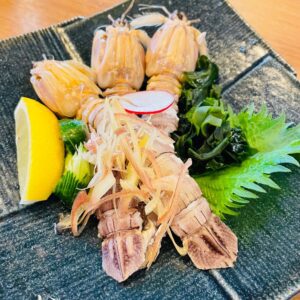
The exquisite dish was “fried Nebuto (cardinal fish)”. Even in the tabelog of “Umi no Kohachi”, it was written that “The recommended dish is Fukuyama’s specialty, fried cardinal fish.” It was a superb dish that goes well with beer and sake with its crispy clothes and easy-to-eat size. Cardinal fish is a white fish with a body length of about 3 to 5 cm that can be caught in the Seto Inland Sea. “Nebuto” is generally called “Indian perch”. It is said that the season is from May to September, so it may have been a little early in the end of March. However, I was very satisfied because it was very delicious.

Four coastal cities in the Bingo area (Fukuyama City, Onomichi City, Mihara City by Hiroshima Prefecture, Kasaoka City by Okayama Prefecture) and fishing-related organizations are promoting the “Bingo Fish” brand. “Bingo fish” is 25 kinds of fish selected by 1,000 fishermen in Bingo. “Nebuto (cardinal fish)” is selected for the summer “Bingo Fish” along with other 7 species. In addition, 7 kinds of seafoods, 3 kinds of seafoods in autumn, 7 kinds of seafoods including mantis shrimp in winter have been selected as “Bingo fish”.
In addition, “fried Nebuto (cardinal fish)” has been selected as “Our Regional Cuisines” in Hiroshima Prefecture by the Ministry of Agriculture, Forestry and Fisheries.
“Small squid tempura” was also delicious with a taste very similar to that of firefly squid tempura. Small squid is “Beika (Beka squid)”, a dialect of the Fukuyama region. “Beika” is written as a rice squid. It was named a rice squid because it has eggs that look like rice grains. The season is from spring to early summer.

5. Jiyuken
After “Umi no Kohachi”, I drank again at “Jiyuken”. “Jiyuken” is a restaurant and izakaya that is loved by locals. It was very crowded when I visited. I really like the atmosphere of “Jiyuken” where everyone can eat and drink at the square-U-shaped counter. I love the square-U-shaped counter because I can see the happy faces of the customers in front of me. Of course, at the square-U-shaped counter, if the food is not delicious, we can see customers with unpleasant faces, which is counterproductive.

I had “Oden”, “stir-fried liver and Chinese chives” and “Deep-frying without breading or batter Kuwai (sagittaria rhizome)” at “Jiyuken”.
“Oden” in “Jiyuken” was covered with sweet miso. It was a little too sweet for me. However, as the “Oden” is written in the “Jiyuken” store, “Oden” is the recommended food for the restaurant. In fact, many people ordered “Oden”. I thought that sprinkling sweet miso on “oden” was a characteristic of “oden” in Fukuyama, so I looked it up website. However, in Fukuyama, we could not find the custom of sprinkling sweet miso on “oden”. It seems to be a unique way of eating “oden” in “Jiyuken”.
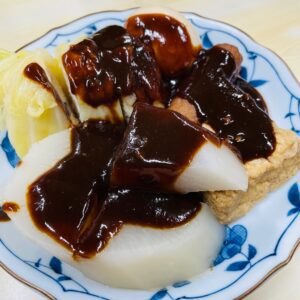
“Stir-fried liver and Chinese chives” was a delicious like eating at basic Chinese restaurant.
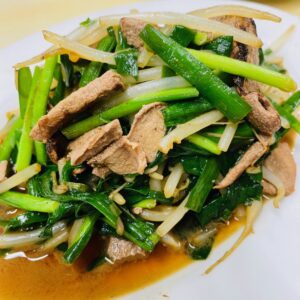
The exquisite dish was “Deep-frying without breading or batter Kuwai (sagittaria rhizome)”. Fukuyama City is Japan’s number one producer of Kuwai, accounting for about 60% of the national production. It is said that cultivation began when the moat of Fukuyama Castle was planted from what was originally native to the swamp. I have never known that Fukuyama City is a major producer of Kuwai. By the way, the environmental image character of Fukuyama City is “Kuwai-chan”.

Since the buds of the Kuwai grow from the fruit, it can be eaten at New Year’s dishes and celebrations as a lucky charm. In fact, I’ve only eaten Kuwai as a New Year’s “Osechi dish”. The deliciousness of the “Deep-frying without breading or batter Kuwai (sagittaria rhizome)” I ate at “Jiyuken” was a pleasant surprise. It was by far the most delicious Kuwai in my life.
Kuwai has been selected as “Sweet cook Kuwai (sagittaria rhizome)” by the Ministry of Agriculture, Forestry and Fisheries in Hiroshima Prefecture’s “Our Regional Cuisines“.
Note: The departure / arrival times, fares of transportation, admission fees, meal fees, etc. listed in the text are as of the time of writing the BLOG. Please check for yourself when you go on a trip as it may change in the future.
